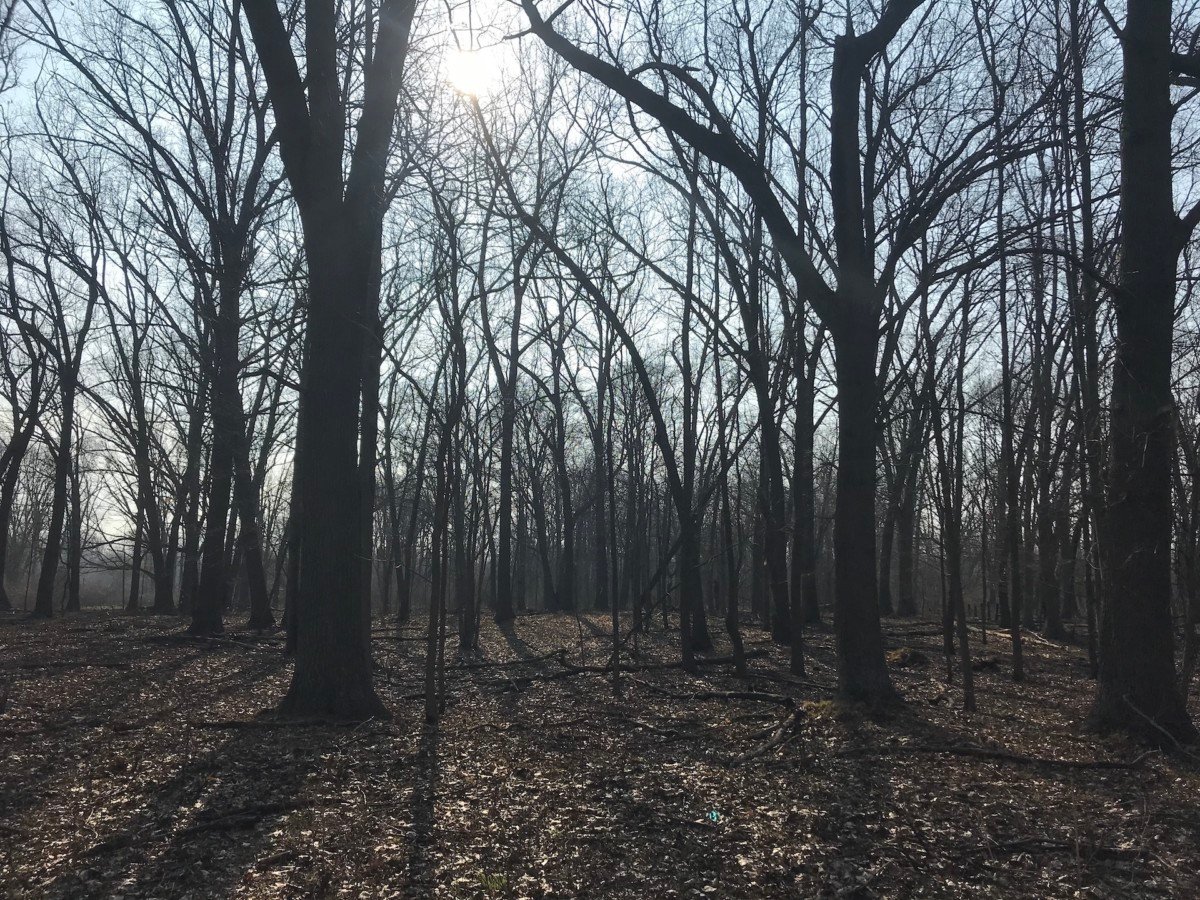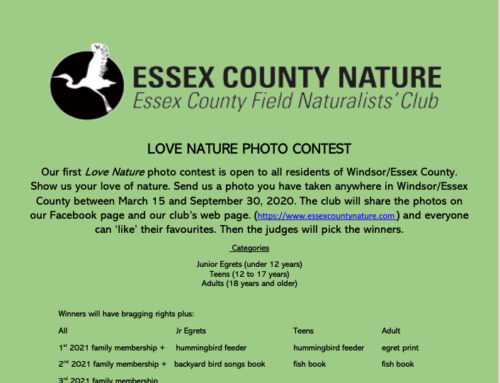
Spring is such an uplifting time of year. The birds are returning from their winter homes, frogs are calling for their mates, trees are bursting with buds, and flowers like trout lily and mayapple are pushing their way up through the moist forest floor. This would be a perfect time for an Essex County Field Naturalists’ Club “pop up” event, perhaps do a “first of the year” sightings list, or go on a multi-sensory hike through different habitats! Unfortunately, due to the emergence of the new virus known as Covid-19, we cannot gather for any events right now… But that doesn’t mean we can’t still go outside and share our experiences! That’s what I did recently, and I brought my nature journal with me to help tell my story. So lend me your imaginations, and let me take you on an early spring “field trip”… Today we are going for a long, slow walk through the Spring Garden Natural Area!
April 7th, 2020, 1:30pm
Spring Garden Natural Area
Clear skies with incoming clouds, ~15°C
Spring Garden is an Area of Natural and Scientific Interest with a mix of dry and wet habitats— tall grass prairie, oak savannah, Carolinian forest, a pond and the Turkey Creek. We will stick to the trails, but it’s good to be aware of the possibility of encountering ticks (Do your tick checks, just in case!). We begin at the south end, walking up a gravel trail that runs alongside the creek. Some little brown birds take off from the ground, disappearing into a tangle of branches on the side of the trail. Overhead, the outstretched wings of gulls, riding the thermals high above, remind me of airplanes. We stop at a small clearing and stand quietly, and we notice the near absence of traffic noises and drop-in to the diversity of other, “more than human” sounds.
Spin in a circle and look up and down. What’s all around? To the south: the trail from which we came, the song sparrows are back on the path, shrubs are at eye level and a giant, cavity-ridden cotton wood carries a poison ivy vine up to the sun. To the west: a dense forest with a strong chorus of chorus frogs singing from dark pools of water. To the north are “the hills”— a large, open, hilly area where the ground shines gold with last year’s grasses and wildflowers. To the east is Turkey Creek, flowing from the Grand Marais ditch and winding its way into the Detroit River. You notice something move on a small island in the creek— a couple of mallards! Apparently undisturbed by our presence, the male tucks his beak back into his feathers while the female stretches a wing.

We stand over the creek for a minute or ten (who’s keeping track of time anyway?). The sun makes you squint and feels slightly toasty on bare skin. A cool breeze freshens the air around us. The ground is soft and damp. A little brown spittlebug shows up unannounced. I open my nature journal and start documenting some findings:


Sensing that it’s time to move on and feeling pulled toward the warm, sunny openness of “the hills”, I decide to put my notebook away. We walk slowly so as not to scare any snakes that might be basking on the sides of the trail. With eyes on the ground, we notice the ages of different plants. The old ones, long but bent, lay flat or propped up about a foot, while the new ones, only a centimetre long, poke straight up and are bright green. Suddenly, by the edge of the field, you hear a distinct and familiar sound: “Drink your TEA!”. We run ahead to get a closer look, and there, in the tree beside us, is the black, rusty-orange and white male Eastern Towhee. What a treat! Meanwhile, another bird flies out from the forest and as it enters the sun it turns blue and you know it’s none other than the Eastern Bluebird. Beauty! And then, there’s a laugh from the sky— a belted king fisher! This is a great day for birds. Now who else can we find?…
A shadow moves across the landscape as a few clouds come in. Moving north-west, we walk down from the hills to the edge of the forest. We are greeted by more sounds of chorus frogs, woodpeckers, blue jays and robins. There are puddles with trees growing out of them. The canopy of the willows is flecked with bright yellow-green, and a cotton wood just dropped a catkin! I pick it up and put it in my pack for a comparison study that I want to do later…
What’s that sound?? A very strange sound! A bubbly “Baaa”, a bit like a sheep. It’s getting closer. We look, and wait. Some red, green, blue and white colours flash through the trees ahead— the colourful clothing of homosapiens! A family rounds a bend in the trail, and we see that the mom has a baby in her arms. They’re doing the thing where you move your finger up and down over your lips while saying “Aaaaaaa”. That baby seems so happy, and why wouldn’t he be? It’s his first-ever spring, and everything is new. We find a spot where the trail gets a bit wider and move to the side, giving that two metre space that is currently recommended for social distancing.
The trail winds and climbs, bringing us to a large pond in the heart of this natural area. Although it is man-made and has lots of phragmites, it is an attraction and is currently bustling with life. We walk around the perimeter of the pond, seeing mallards, geese, a pair of king fishers flying overhead, and a pair of buffleheads swimming about twenty meters away. The first dragonflies— Green Darners— are spotted near the shore. These are awesome to watch— large, colourful predators that zig zag through the air. A mating pair lands in front of us but never stays still long enough for a photo. On the sandy berms of the pond, ground nesting bees poke their heads out of holes, and a mourning cloak butterfly, with its light-tipped, dark wings, disappears into the forest.

Travelling north, we enter some prime oak savannah. This area received prescribed burns on March 14th and 15th, and still smells of burnt organic matter. The open understory lets you see far into the distance— far enough that things start to look hazy. Nothing but big old oak trees. It’s surprisingly quiet, but you know these oaks can support hundreds of species of insects, so there is certainly diversity here too.
The prescribed burns were done in sections going all the way to the far north end of the park. Here, the habitat changes again into a small and precious patch of prairie. Pausing at the end of the trail, you notice some chickadees around a small tree. The tree has some holes in it. Sure enough, the chickadees are going in and out of one particular hole. This would be a nice spot to come back to over the next few weeks to hopefully observe the busy nesting behaviour of a chickadee family.
It’s time to start the journey home, but we only quicken the pace a little, stopping often as we never cease to see something new. An oak tree from another angle might reveal a cavity fit for an owl! Coming back to the pond, I find an aspen tree— it too is dropping it’s catkins! Compared to the cotton wood, these ones are larger and remind me very much of caterpillars. And then, just as we are about to move on, something purple catches your eye. A patch of common blue violets! They may be small, but when you get down to their level and see how their five vibrant petals light up in the sun, you can’t believe you almost missed them.

We take another look at the pond, from the south end, looking north. The water is doing something really cool right now… a rainbow! Not a reflection from the sky, but some kind of phenomenon on the surface of the water. It only lasts a moment before more clouds block the sun, but in that moment I capture this photo:

Back at “the hills”, we notice the sky and realize how much time has passed. The sun is low on the horizon. And my stomach is grumbling. Turkey Creek shows us the way home, the straight stretch of trail we walked a few hours ago. But just as you think the adventure is over, one more thing grabs your attention— a young brown snake, no bigger than your hand, is coiled up on the trail. Frozen in its defensive posture, but really quite defenceless, I admire it and then shoo it off to the side where it should be safe from getting accidentally stepped on or rolled over by a speedy bike. Well worth that final look! Good luck little guy.

And so that brings us to the end of this field trip. Thank you for joining me! I hope that in some way you felt like you were there too, especially if you’re currently trapped inside or struggling with social isolation. In retelling my story, I got to experience it on another level, and I am feeling very grateful for seeing those first dragonflies of the year, the chickadees preparing their nest, and helping that snake off the trail. I am lucky to live close to such an amazing natural area and am taking full advantage of all the time I have now to explore. I look forward to hearing some of your nature stories too, and hopefully going on outings together in person again some day soon. In the meantime, stay safe everyone, and may we find peace and wonder in nature now and always.
~Jessica



You must be logged in to post a comment.